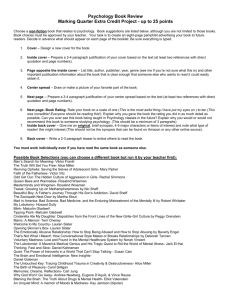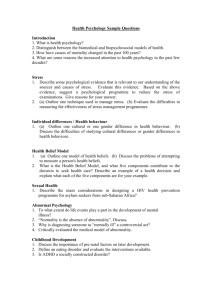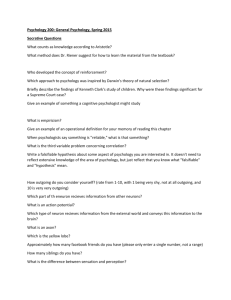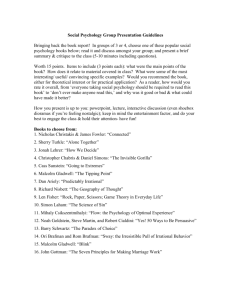AP Psychology Final Project Guidelines
advertisement
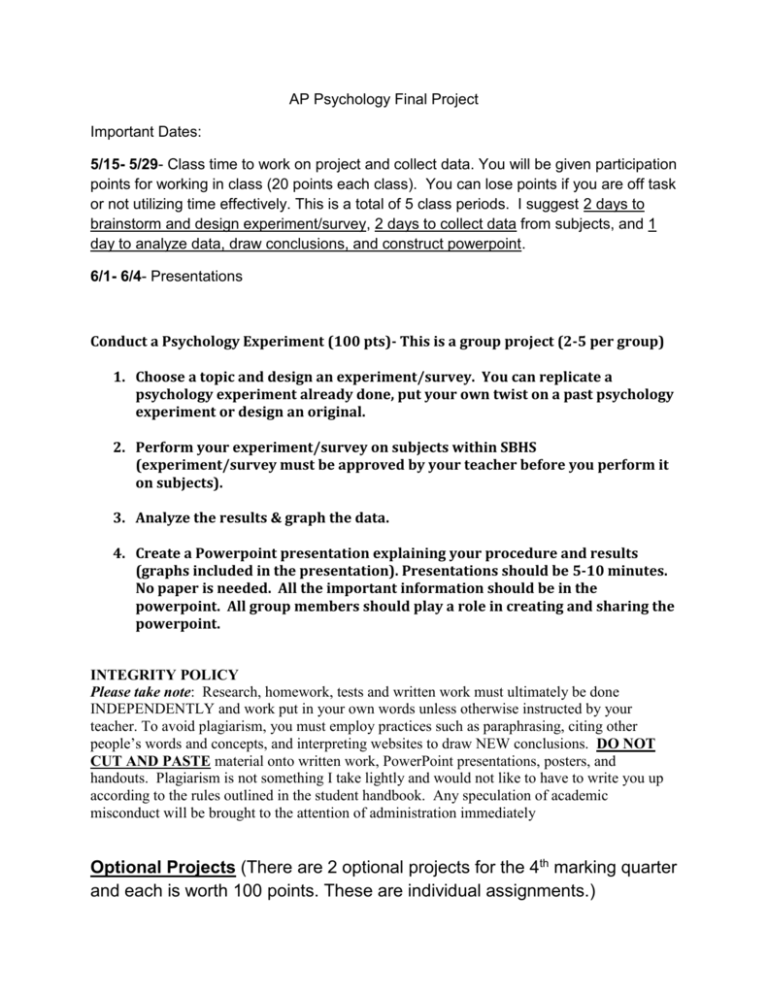
AP Psychology Final Project Important Dates: 5/15- 5/29- Class time to work on project and collect data. You will be given participation points for working in class (20 points each class). You can lose points if you are off task or not utilizing time effectively. This is a total of 5 class periods. I suggest 2 days to brainstorm and design experiment/survey, 2 days to collect data from subjects, and 1 day to analyze data, draw conclusions, and construct powerpoint. 6/1- 6/4- Presentations Conduct a Psychology Experiment (100 pts)- This is a group project (2-5 per group) 1. Choose a topic and design an experiment/survey. You can replicate a psychology experiment already done, put your own twist on a past psychology experiment or design an original. 2. Perform your experiment/survey on subjects within SBHS (experiment/survey must be approved by your teacher before you perform it on subjects). 3. Analyze the results & graph the data. 4. Create a Powerpoint presentation explaining your procedure and results (graphs included in the presentation). Presentations should be 5-10 minutes. No paper is needed. All the important information should be in the powerpoint. All group members should play a role in creating and sharing the powerpoint. INTEGRITY POLICY Please take note: Research, homework, tests and written work must ultimately be done INDEPENDENTLY and work put in your own words unless otherwise instructed by your teacher. To avoid plagiarism, you must employ practices such as paraphrasing, citing other people’s words and concepts, and interpreting websites to draw NEW conclusions. DO NOT CUT AND PASTE material onto written work, PowerPoint presentations, posters, and handouts. Plagiarism is not something I take lightly and would not like to have to write you up according to the rules outlined in the student handbook. Any speculation of academic misconduct will be brought to the attention of administration immediately Optional Projects (There are 2 optional projects for the 4th marking quarter and each is worth 100 points. These are individual assignments.) Due Dates: Seniors enrolled in Senior Society: June 3(A) & June 4(B) Juniors & Seniors not attending Senior Society: June 11(A) & June 12(B) Option 1: Psychology Book Review Project Choose a non-fiction book that relates to psychology. Book suggestions are listed below, although you are not limited to those books. Book choices must be approved by your teacher. Your task is to create an eight-page pamphlet advertising your book to future readers. Decide in advance what should appear on each page of the booklet. Be sure everything is typed. 1. Cover – Design a new cover for the book. 2. Inside cover – Prepare a 3-4 paragraph justification of your cover based on the text (at least four references with direct quotation and page numbers). 3. Page opposite the inside cover – List title, author, publisher, year, genre (see me if you’re not sure what this is) and other important publication information about the book that is clear enough that someone else who wants to read it could easily obtain it. 4. Center spread – Draw or make a picture of your favorite part of the book. 5. Next page -- Prepare a 3-4 paragraph justification of your center spread based on the text (at least four references with direct quotation and page numbers). 6. Next page- Book Rating- Rate your book on a scale of one (This is the most awful thing I have put my eyes on.) to ten (This was incredible! Everyone should be reading this!). Explain why you gave the book the rating you did in as much detail as possible. Can you ever see this book being taught in Psychology classes in the future? Explain why you would or would not recommend this book to someone studying psychology. (This should be a minimum of 3 paragrahs) 7. Inside back cover – Give me an original, brief synopsis, 4-5 major characters or items of interest and note what type of reader/ this might interest (This should not be the synopsis that can be found on Amazon or any other online source). 8. Back cover – Write a 2-3 paragraph teaser to entice others to read the book. You must work individually even if you have read the same book as someone else. Possible Book Selections (other book selections need to be approved by teacher): Man’s Search for Meaning- Viktor Frankl The Truth Will Set You Free- Alice Miller Reviving Ophelia: Saving the Selves of Adolescent Girls- Mary Pipher Odd Girl Out: The Hidden Culture of Aggression in Girls- Rachel Simmons Queen Bees and Wannabes- Rosalind Wiseman Masterminds and Wingmen- Rosalind Wiseman Tweak: Growing Up on Methamphetamines by Nic Sheff Beautiful Boy: A Father's Journey Through His Son's Addiction- David Sheff The Sociopath Next Door by Martha Stout Mad in America: Bad Science, Bad Medicine, and the Enduring Mistreatment of the Mentally Ill by Robert Whitaker My Lobotomy- Howard Dully Blink- Malcolm Gladwell Tipping Point- Malcolm Gladwell Cinderella Ate My Daughter: Dispatches from the Front Lines of the New Girlie-Girl Culture by Peggy Orenstein Manic: A Memoir- Terri Cheney Welcome to My Country- Lauren Slater The Emotionally Abusive Relationship: How to Stop Being Abused and How to Stop Abusing- Beverly Engel That's Not What I Meant!: How Conversational Style Makes or Breaks Relationships by Deborah Tannen Voluntary Madness: Lost and Found in the Mental Healthcare System by Norah Vincent The Lobotomist: A Maverick Medical Genius and His Tragic Quest to Rid the World of Mental IllnessJack El-Hai Thinking, Fast and Slow- Daniel Kahneman Quiet: The Power of Introverts in a World That Can't Stop Talking - Susan Cain The Brain and Emotional Intelligence: New Insights- Daniel Goleman The Untouched Key: Tracing Childhood Trauma in Creativity & Destructiveness- Alice Miller The Birth of Pleasure- Carol Gilligan Memories, Dreams, Reflections- Carl Jung An Unquiet Mind: A memoir of Moods & Madness- Kay Jamison (bipolar) Is There No Place On Earth For Me- Susan Sheehan (schizophrenia) Songs of the Gorilla Nation- Dawn Prince-Hughes (autism) Nobody Nowhere- Donna Williams (autism) Brain Sex: The Real Difference Between Men & Women- Anne Moir & David Jessel The Boy Who Was Raised As A Dog- Bruce D. Perry and Maia Szalavitz In Search of Memory- Eric Kandel An Anthropologist on Mars- Oliver Sacks The Body Project: An Intimate History of American Girls- Joan Jacobs Brumberg The Lucifer Effect- Philip Zimbardo Stalking Irish madness: searching for the roots of my family….-Patrick Tracy Hurry down sunshine-Michael Greenberg Scattershot: My bipolar family: A memoir-David Lovelace Three little words: A Memoir- Rhodes-Courter Electroboy: A Memoir of mania- Andy Behrman Catch me before I fall- Rose Childs Blue Genes: A memoir of loss and survival-Christopher Lukas Option 2: DSM-IV and the Movies Pick a movie character you’d like to analyze. The character does not have to have an obvious mental disorder. In fact, do NOT choose a character where they are labeled with a disorder in the movie. Choose any character that is quirky or eccentric and you can probably make a decent case for a diagnosis. In the past, students have diagnosed Darth Vader, Shrek, and Captain Jack Sparrow. Watch your movie and then diagnose a character using the criteria from the DSM-V. Follow the procedure listed below for the proper format. Enjoy yourself and don’t forget the popcorn! Requirements: 1. Mechanical guidelines: - typed, 12 point font, double spaced, 3 pages - sections should be headed (Case History, Diagnosis, Cause of Behavior) - paper has been proof-read and edited to eliminate typos and grammatical errors 2. Citation: Use in-text, APA-style citation and include a bibliography You may consult with other students and share ideas, but you must write your own paper. No cutting and pasting, cheating, plagiarizing, or dishonesty of any sort! 3. The Paper: a. Title – make it interesting b. Case History - Describe the character(s) fully. Include background information (name, age, family information, important events, etc), relevant past events, and explain what led this person to seek help from a therapist. Tell me about the character, not the movie plot. Depending on the character you choose, the plot of the movie may not be relevant. Be thorough in your description so that I get a feel for your character. You should not make up information for this section if it is unknown, but you can use inferences. For example, you may not know the character’s exact age, but you can infer that he is in his 20’s. Also, you may be able to find character information online at sources like www.imdb.com or Wikipedia, but be sure to cite them correctly! c. Diagnosis: Consult the DSM-V and give me your diagnosis of the mental disorder or personality disorder that you think they exhibit. Not only should you give me the name of the disorder(s) the person has, but outline for me the exact criteria from the DSM-V that you feel warrants this diagnosis and explain scenes from the movie that demonstrate this symptom (quotes are good here). Also, explain any of the criteria that the character does not fit. This is the heart of the paper. Go through each diagnostic criterion and analyze the behavior in light of it. Note: if you diagnose your character with schizophrenia, you must first demonstrate that they have the disease and then name and defend the subtype. You can find the DSM-IV at your local library or you can consult the diagnostic criteria online at: http://www.behavenet.com/capsules/disorders/dsm4TRclassification.htm d. Cause of the behavior – Speculate as to WHY the person developed this disorder. We’re talking causation here. How did the disorder develop? Nature/Nurture? e. Conclusion- Final paragraph should be a conclusion with your final thoughts regarding this character.
